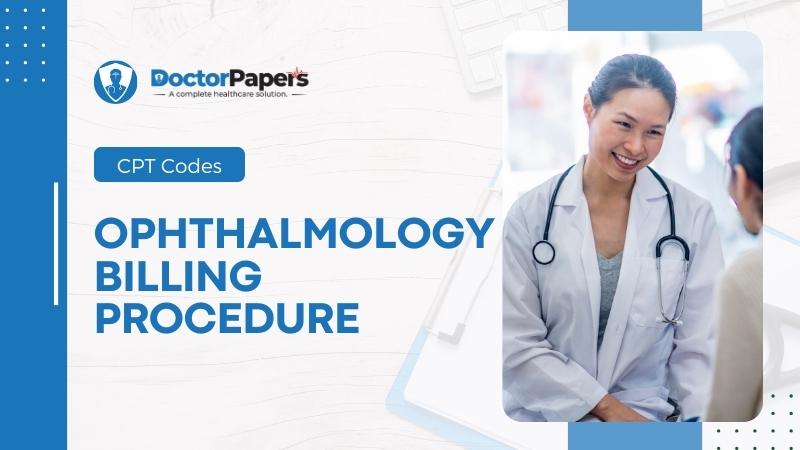Ophthalmology is a specialty that requires specific CPT codes so that doctors can get paid for their services. An ophthalmologist is a doctor who specializes in the eyes and visual system, diagnosing and treating a wide variety of eye conditions. Just like in every other branch of medicine, medical billing is crucial in ophthalmology. Ophthalmology medical billing necessitates using two sets of codes—E&M and eye codes. Accurate medical billing and coding can be complicated in ophthalmology because of two distinct code sets. For this reason, ophthalmology practices must have reliable medical billing systems in place. Ophthalmologists must use ophthalmology-specific CPT codes when reporting patient care. The codes are in the CMS annual NCCI manual, compiled by the National Correct Coding Initiative. Moreover, medical billing for ophthalmology necessitates a comprehensive knowledge of the following subspecialties:
- Retina
- Glaucoma
- Pediatric
- Eye plastics
CPT CODES FOR OPHTHALMOLOGY
CPT codes for ophthalmology are necessary for accurate billing and reimbursement. They provide a standard language for describing the services provided by ophthalmologists and other eye care professionals. CPT codes also help ensure that all providers are paid fairly for their services and that they are accurately documented for future reference. Let’s look over all the essential CPT codes used for ophthalmology procedures. 92310: The physician handles prescribing and fitting contact lenses for both eyes, except when the patient has aphakia due to removing the eye’s lens. 92311: The doctor prescribes and inserts a corrective lens in one of the patient’s aphakic (cataract-free) eyes. 92313: Contact lens prescriptions should include the lenses’ optical properties, which improve the patient’s vision and size and shape, which help them fit appropriately in the eyes. 92316: The physician recommends corneal contact lenses for both eyes of an aphakia patient. He controls the independent technician’s lens-fitting process. 92340-92371: Optical Services Including Prosthetics for Aphakia: 92352: A procedure in which patients who have had cataract surgery and had their natural crystalline lens removed are fitted with spectacles with a single designated focal length. 92354: A magnifying lens is attached to the spectacles to enhance the patient’s close vision for activities such as reading. 92370: When a patient doesn’t have aphakia or no lens in the eye, the provider adjusts or fixes their eyeglasses. 92499-92499:
Additional Ophthalmological Treatments or Services
92499: Not-specifically-coded ophthalmological procedures. 92012 – Complete eye examination: This code denotes a regular eye test that involves an assessment of the patient’s eyesight, refractive error, ocular movement, and binocular vision. In addition, a dilated fundus examination may be performed to look for evidence of illness or abnormalities. 66982: Surgically removing extracapsular cataracts and inserting an intraocular lens prosthetic. 66984: Endoscopic laser extraction of extracapsular cataracts and implantation of intraocular lens prostheses 67101: Cryotherapy or diathermy for retinal detachment repair, with or without subretinal fluid drainage 67210: Photocoagulation: a single- or multiple-session procedure for the destruction of a localized retinal lesion (such as macular edema or tumors). 92133 – Diagnostic Imaging Using Optical Coherence Tomography: An OCT imaging examination of the retina is designated with the CPT code 92133. OCT is a noninvasive technique that produces high-resolution retinal pictures using light waves. 65778 – Crosslinking of Corneal Collagen: As described by the CPT code 65778, corneal collagen crosslinking is used to treat keratoconus, a disorder characterized by the bulging and thinning of the cornea. 92020 – Gonioscopy: Gonioscopy is a diagnostic test that looks at the angle of the eye’s anterior chamber. It is described by the CPT code 92020. Usually, glaucoma patients are evaluated using this method. 92235 – Angiography with fluorescein: Fluorescein angiography, a diagnostic procedure that uses a dye and a specialized camera to inspect the blood vessels in the retina, is designated by the CPT code 92235. 67028 – injection intravitreal: Intravitreal injections entail injecting medication into the vitreous, a gel-like fluid that fills the eye’s posterior chamber. Usually, this surgery is used to cure diseases, including diabetic retinopathy and age-related macular degeneration. Conclusion: CPT codes are used to describe the services provided to patients accurately and to determine reimbursement for services. CPT codes are constantly changing, so staying up to date with the latest codes and understanding the nuances of coding is essential. With the proper knowledge and understanding, ophthalmologists can use CPT codes to accurately and efficiently document and bill for their services.










